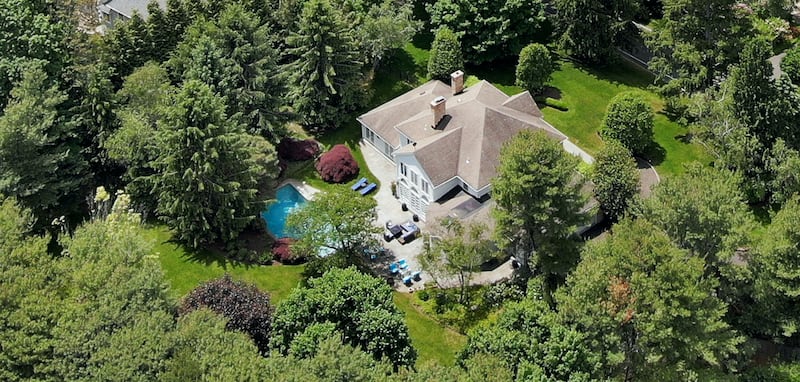In Auckland, a home without a toilet and in need of complete renovation has just sold for 2 million New Zealand dollars (€1.2 million). In Connecticut, a $1 million home (€850,000) will sell in a weekend. In Glasgow, there are waiting lists to even view a property.
Yes, property prices might be rocketing ahead in Ireland at present – up by 5.5 per cent on an annual basis in May according to the latest stats – but around the world, prices are rising far faster.
Indeed Knight Frank’s Global House Price Index, which benchmarks average prices across 56 countries and territories, rose by 7.3 per cent in the year to March 2021 – the fastest rate of increase since the last quarter of 2006. And many markets are rising far faster than the average.
But where are prices rising fastest – and where will it all end?

Global hotspots
It’s not what one might have expected; that amidst the most serious pandemic in quite some time, house prices would soar.
"It did sort of defy people's expectations. It's the first time we've seen an economic downturn result in, in some cases, a significant increase in house prices," says Sophie Chick, a director in world research with Savills in London, noting however the pandemic led circumstances were experienced right across the world.
“It was quite a unique scenario in that most of the world had lockdowns, so it’s really been quite unique to see unified growth in many locations,” she says.
A lack of supply is one factor which is common in most markets posting double digit growth figures.
“We’ve had an undersupply for a while, but this was only made worse when construction had to stop,” says Chick, adding that other factors include people becoming more aware and demanding of their home environment, government incentives to boost the market, such as the stamp duty holiday in the UK, and record low interest rates.
The impact of the pandemic has also seen more of a move out of cities into surrounding areas.
This is something Clodagh McCoole, a realtor with Berkshire Hathaway Home Services, has seen in the "very buoyant" Connecticut market, which, she says, has been driven largely by an exodus of people from New York.

“During the pandemic in 2020 when things were extremely bad in New York, we saw lots of families coming to Connecticut – initially for summer rentals but ultimately looking to buy,” she says, noting that good schools and lower property taxes were a draw.
“Primarily though people were looking for space and in particular outdoor space”.
It’s not all common factors, however; Turkey is currently the hottest property market in the world, but this is being driven by inflation as much as fundamentals. In the 12 months to March 2021, prices rose by a staggering 32 per cent, according to the Knight Frank report. It means that three of the top five fastest-growing cities in the world are in Turkey: Izmir (+33.9 per cent), Ankara (+30.3 per cent) and Istanbul (+28.8 per cent).
However, when inflation is stripped out, prices are increasing on a real basis of about 16 per cent a year, according to Knight Frank.
This is because money is pouring into Turkish property due to president Recep Tayyip Erdogan’s interventions to keep interest rates low, which have caused investors to move out of the Turkish lira and into hard assets such as property. Inflation is expected to end the year at about 16 per cent.
The world’s fastest growing cities
1 Izmir 33.9 per cent annual growth
2 Ankara 30.3 per cent
3 Wellington 30.1 per cent
4 Istanbul 28.8 per cent
5 Seoul 26.1 per cent
6 Halifax 22.5 per cent
7 Moscow 22.4 per cent
8 St Petersburg 22.1 per cent
9 Hamilton 20.9 per cent
10 Phoenix 20 per cent
Dublin comes 114th, with 2.2 per cent growth
Expat havens
While those searching for a home in Ireland may be struggling, they’re not the only ones. Irish people living abroad will also find it difficult to put down roots given the direction of property prices in many popular overseas locations.
Indeed, five of the top 20 fastest growing global markets are some of the most common for Irish living overseas. Unsurprisingly New Zealand leads the charge in second, followed by the US (5), Canada (11), the UK (12) and Australia (18).
New Zealand may have thus far weathered the Covid-19 storm far better than most, but it is propelling its property market to new heights. It is the second fastest-growing property market in the year to end March 2021, with annual growth of 22.1 per cent, while Wellington is posting staggering annual growth of 30.1 per cent to make it the third fastest growing city, with Auckland in 11th, based on annual growth of 19.6 per cent.
It means that the task for a first-time buyer is incredibly challenging: Auckland now has a median price of 1.15 million New Zealand dollars (€680,963), according to the Real Estate Institute, with a national median price of 820,000 New Zealand dollars (€485,556). Contrast this with a median price of €392,500 for Dublin and €265,000, nationally.
The Government has taken steps to quell price growth; in March, the remit of the central bank was changed to allow it consider house prices when making monetary policy, while it has also tightened its mortgage lending rules. This means that as of May, only 20 per cent of borrowers can borrow more than 80 per cent of the value of a property.
However the problem, as with other markets around the world, is that supply is simply insufficient to meet demand.

The world’s fastest growing countries
1 Turkey 32 per cent annual growth
2 New Zealand 22.1 per cent
3 Luxembourg 16.6 per cent
4 Slovakia 15.5 per cent
5 United States 13.2 per cent
6 Sweden 13 per cent
7 Austria 12.3 per cent
8 Netherlands 11.3 per cent
9 Russia 11.1 per cent
10 Norway 10.9 per cent
Ireland comes 41st, with 3.7 per cent growth
Growth factors
This lack of supply has hit the Connecticut market, typically home to hedge fund billionaires and Manhattan commuters, hard.
“Price growth is being driven by a lack of inventory and more buyers than available properties,” says McCoole.
Consider the typical sale of a home on the market for $1 million or less. According to local agent McCoole, such houses are generally listed on a Thursday/Friday, with showings concentrated over the weekend, sometimes with a public open house on Sunday afternoon from 1-3pm. Highest and best offers are then expected by 7pm on Sunday evening.
Sold in a weekend.
“Buyers are having to offer significantly over asking price and where possible to waive any contingencies in order to secure the house,” she says, noting that there are stories of buyers offering on up to 15 properties before finally getting a house, while cash offers are typically the ones that win.
In the UK, Glasgow is one of the fastest growing markets, with prices advancing by 14.3 per cent in the year to end-March 2021, according to Knight Frank.
Local agent Craig Jamieson, branch partner of Pacitti Jones, says gentrification of the south side of the city, and the arrival of artisan bakeries and delis has brought buyers over from the traditionally more popular west end of the city, pushing up prices.
This has been compounded by pandemic-specific factors, such as the boost in savings, as well as the growing imbalance between supply and demand.
“Stock levels were already petering out, (but the pandemic) definitely tipped it over the edge,” he says.
As in other cities around the world, this has translated into strong demand for properties, with those in the £100,000-£250,000 range attracting as many as 60-70 buyers.
“We’ve had a record-breaking number of viewers … so for the first time ever in 20 odd years I’ve had to cap viewings,” says Jamieson.
This means that it’s first come, first serve, with those who don’t make the cut put on a waiting list to view a property. Jamieson also vets potential bidders to ensure they have finance in place before viewing.
Viewing takes place over two weeks, with bids then invited under the Scottish offers over system. However, as Jamieson notes, in this market a house will typically sell for 10-15 per cent more than the price indicated.
“In essence, the offers over is a bit meaningless, as no properties will sell at the offers over level”.

Property bubble?
Such buoyancy in so many markets does make one wonder how far will prices go.
As Knight Frank notes in its report, with 13 countries recording double-digit price growth in the period, talk of post-pandemic housing bubbles is increasing.
This time around however, the expectation is that it will be different.
For one, governments around the world have started ramping up cooling measures. Since January 2021 for example, Knight Frank notes that authorities in China and New Zealand have intervened with a range of measures from tighter lending rules to higher stamp duties for multiple purchases, while Canada is also looking closely at a national vacancy tax and China is mulling over a national property tax.
“With governments taking action and fiscal stimulus measures set to end later this year in a number of markets, buyer sentiment is likely to be less exuberant, plus, the threat of new variants and stop/start vaccine roll-outs have the potential to exert further downward pressure on price growth,” notes the report.
Moreover, the advent of lending rules and stricter approaches from banks and lenders means that this environment is substantially different this time around.
“I think the lending community has been much stricter in terms of what they’re willing to lend,” says Chick, noting that the memory of the last property crash is still fresh in the minds of many.
“We’re a lot less likely to see people defaulting on their mortgage, so it’s unlikely to see a situation like we saw before,” she adds.
And, as time goes on, markets may become more reliant on local factors. So while a bubble may not be building, some markets will still see growth.
In Connecticut for example, McCoole doesn’t see the current dynamics as being a “temporary blip”.
“People have got used to a different way of life and for many giving up the idea of extra space in the suburbs for a life in a smaller city apartment is not something they are willing to consider,” she says, noting that demand from parents trying to get children into schools and those who have to leave their rental because their landlord is selling, “are all going to continue driving the prices up for the foreseeable future”.
Price growth may slow however, driven by higher interest rates and a return to work in Manhattan.
Similarly in the UK, incentives such as the stamp duty holiday are being wound down.
“This will see price growth slow down,” says Chick.
In Glasgow, Jamieson expects price growth to level off next year, as the impact of the end of furloughing is felt, while a potential second referendum on Scottish independence could have “a negative impact” on the property market.
The flattest markets
It’s also worth noting that not every market is growing.
While there are common themes across the world, the Knight Frank survey of 143 global cities shows that 22 cities are still seeing prices decline year-on-year, with several key cities in India, Spain, Italy and Israel among them.
Prices in Lisbon fell by 3.7 per cent in the year to end-March 2021 for example, while in Seville they fell by 3 per cent, by 1.5 per cent in Madrid, and 0.9 per cent in Florence.
And Dublin may be a city where prices are still growing, but in terms of the rate of growth, it’s far down the table, ranking 114th with annual growth of 2.2 per cent.












